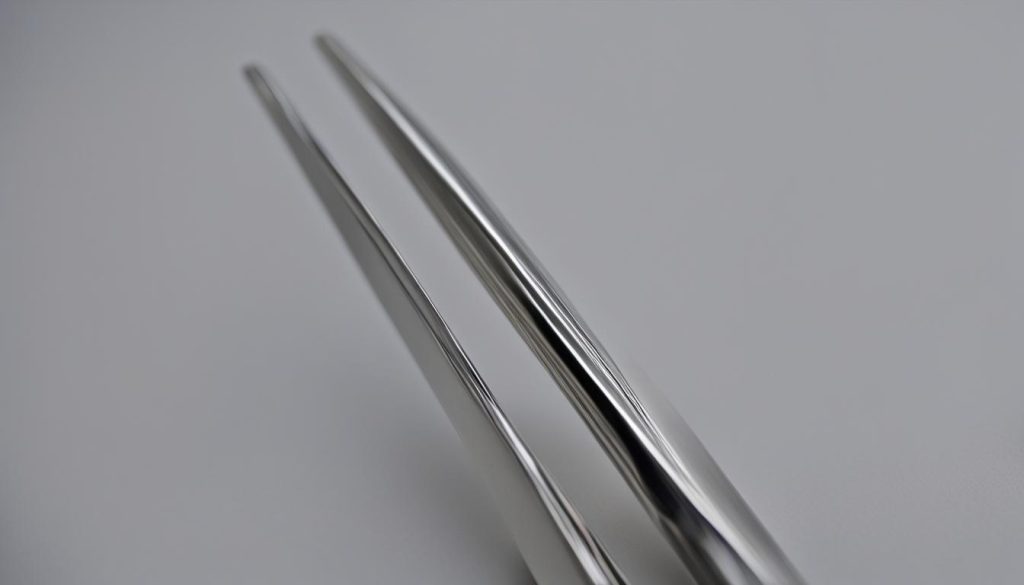
Are you curious about the role of a tuning fork in medical diagnosis and its uses in healthcare?
Here I will explore what is a tuning fork used for in medicine and how it plays a crucial role in various medical applications.
A tuning fork is an acoustic instrument calibrated to specific frequencies. When struck, it produces sound waves that have significant advantages in medical settings.
The vibrations created by the tuning fork can assist in diagnosis, promote healing, and bring the body and mind into balance.
In healthcare, tuning forks are widely used for testing hearing, stimulating Qi flow, and reducing stress and anxiety.
They have a positive impact on the body’s energy fields, restoring harmony and overall well-being.
By understanding the parts of a tuning fork and how it works, we can further appreciate its importance in medical practices.
Next, we will delve into the anatomy of a tuning fork and explore its unique vibrations and frequency.
Stay tuned for the next section where we will discuss the parts of a tuning fork in detail and how each contributes to its function.
Content
Parts of a Medical Tuning Fork
A medical tuning fork is a simple yet essential instrument used in medical and therapeutic settings. Understanding the different parts of a tuning fork can provide valuable insight into its function and effectiveness.
Let’s explore the anatomy of a tuning fork and learn about its various components.
Prongs
The prongs, also known as tines, are the main vibrating elements of a tuning fork. They are typically made of a sturdy metal alloy and are designed to create audible sound waves when struck.
The length and thickness of the prongs determine the specific frequency at which the tuning fork vibrates.
Stem
The stem connects the prongs to the footpiece of the tuning fork. It acts as a solid support and allows the vibrations produced by the prongs to transmit through the instrument.
The length and thickness of the stem can influence the resonance and quality of the sound produced.
Footpiece
The footpiece is the base of the tuning fork and serves as a handle for holding the instrument. It provides stability and allows for easy placement on the body or other surfaces during medical or therapeutic applications.
The footpiece is often designed to be ergonomic, ensuring a comfortable grip for the user.
Weights
In some tuning forks, small weights may be attached to the tips of the prongs. These weights serve to deepen the vibration produced by the fork, resulting in a lower pitch and a more profound resonance.
The addition of weights can enhance the therapeutic effects of the tuning fork, particularly when working directly on the body.
Understanding the different parts of a tuning fork is crucial for utilizing the instrument effectively in medical and therapeutic applications.
Each component plays a role in the overall function and resonance of the tuning fork, allowing for precise and targeted use in promoting healing and well-being.
How a Tuning Fork in Medicine Works?

A tuning fork is a fascinating instrument that operates on the principles of vibration and frequency.
When a tuning fork is struck, it starts to vibrate rapidly, producing sound waves.
These vibrations occur at a specific frequency, measured in hertz (Hz), which indicates the number of times the tuning fork vibrates per second.
The vibrations created by the tuning fork generate waves that travel through the air, disrupting the surrounding air molecules.
As the waves propagate, they eventually reach our ears, where they are perceived as sound. The pitch of the note produced by a tuning fork is determined by the speed at which it vibrates.
Higher frequencies result in higher-pitched sounds, while lower frequencies produce lower-pitched sounds.
The unique vibrations and frequency of a tuning fork make it a valuable tool in medical applications.
The precise calibration of the tuning fork allows for accurate diagnosis and measurement of various conditions. For example, tuning forks can be used to test hearing by comparing the patient’s perception of sound in different frequencies.
They can also aid in the assessment of neurological function and in determining the presence of bone fractures.
The Vibrations of a Tuning Fork in Action
When a tuning fork is struck, the vibrations caused by its movement can be visualized using a technique called “Chladni patterns.”
These patterns emerge when a fine powder, such as sand or salt, is sprinkled onto a flat plate and the tuning fork is placed on the plate.
As the tuning fork vibrates, the powder rearranges itself into unique patterns that correspond to the specific frequency and mode of vibration of the fork.
This visualization technique demonstrates the powerful impact of a tuning fork’s vibrations and how they can affect the surrounding environment.
By harnessing the vibrations of a tuning fork, medical professionals can leverage their unique properties to support healing, promote balance, and facilitate accurate diagnosis.
Why Are Tuning Forks Used for Healing with Sound Therapy?

Tuning forks have become a popular tool in sound therapy for their unique ability to promote healing and balance.
The vibrations produced by tuning forks have a profound impact on the body’s energy fields, helping to restore harmony and well-being.
Sound therapy with tuning forks can be beneficial for reducing stress and anxiety, improving sleep quality, and supporting emotional healing.
Through the use of sound therapy, tuning forks can help alleviate physical and emotional imbalances by bringing the body and mind into a state of resonance.
When a tuning fork is struck and placed on specific areas of the body, the vibrations it produces create a soothing effect that can help relax muscles, relieve pain, and stimulate the body’s natural healing processes.
One of the main benefits of using tuning forks in sound healing is their ability to synchronize brainwave activity.
The vibrations generated by the tuning forks can help entrain the brain to a specific frequency, inducing a state of deep relaxation and promoting a sense of calm.
This can be particularly helpful for individuals dealing with stress, insomnia, or other conditions that affect sleep and relaxation.
Benefits of Tuning Forks in Sound Healing:
- Promotes relaxation and stress reduction
- Enhances sleep quality and aids in insomnia relief
- Supports emotional healing and releases negative emotions
- Improves focus and concentration
- Elevates mood and promotes a sense of well-being
By incorporating tuning forks into sound therapy sessions, individuals can experience the profound benefits of vibrational therapy and tap into the body’s natural ability to heal and restore balance.
Whether used in professional settings or for personal self-care practices, tuning forks offer a gentle and non-invasive approach to promoting overall wellness and enhancing the mind-body connection.
Types of Tuning Forks
When it comes to using tuning forks for various applications in medicine and sound therapy, there are two main types to consider: unweighted tuning forks and weighted tuning forks.
Unweighted tuning forks are primarily used for healing the body’s energy fields, balancing the chakras, and promoting relaxation and stress relief.
When struck, they create a louder sound compared to their weighted counterparts. However, unweighted tuning forks do not hold their vibration for as long.
On the other hand, weighted tuning forks are excellent for working directly on the body to relax muscles, alleviate pain, and stimulate healing in specific areas.
They produce a quieter sound when struck but hold their vibration for a longer duration. This makes them ideal for targeted therapy and specific applications.
Uses of Different Types of Tuning Forks
The choice between unweighted and weighted tuning forks depends on the specific desired therapeutic outcome.
Here are some examples of how each type is commonly used:
- Unweighted tuning forks: These forks are often used for energy work, such as balancing the body’s chakras, clearing stagnant energy, and promoting overall relaxation and well-being.
- Weighted tuning forks: These forks are utilized for more physical applications, including stimulating acupressure points, relieving muscle tension, and supporting the body’s natural healing processes.
It’s important to note that while unweighted tuning forks are primarily used for energetic and spiritual purposes, they can still have physical benefits.
Similarly, weighted tuning forks can also influence the body’s energy fields and promote overall well-being.
The choice between the two types ultimately depends on the specific needs and preferences of the individual.
How to Use Tuning Forks for Healing
Tuning forks can be used in various ways for healing purposes. Tuning fork therapy involves striking the fork and placing it on specific areas of the body that may benefit from the vibrations.
This technique can help alleviate pain, promote relaxation, and stimulate the body’s natural healing processes.
There are different tuning fork techniques that can be applied, such as using the fork to sweep the energy field around the body or holding it close to the ears to stimulate specific acupressure points.
These techniques can be learned and practiced by individuals to support their own self-care routines.
Incorporating tuning forks into daily rituals can also be beneficial. For example, using a tuning fork before meditation or yoga sessions can help quiet the mind and enhance the overall experience.
Tuning forks can also be used to clear space and set intentions, creating a harmonious environment and promoting personal growth.
Whether used for therapy, self-care, or rituals, tuning forks offer a unique and effective way to harness the power of sound vibration for healing and well-being.
Using Tuning Forks for Self-Care
Tuning forks can be a valuable tool for self-care. Here are a few ways to incorporate them into your routine:
- Use tuning forks before meditation or yoga sessions to enhance focus and relaxation.
- Hold a tuning fork close to your ears to stimulate acupressure points and promote balance.
- Experiment with different techniques, such as sweeping the energy field around your body with a tuning fork, to find what works best for you.
Tuning Fork Rituals
Tuning fork rituals can help create a harmonious environment and support personal growth. Here are a few ideas to get started:
- Use a tuning fork to clear space before practicing meditation or engaging in other spiritual practices.
- Set intentions by striking a tuning fork and focusing on your desired outcome.
- Combine tuning forks with crystals to amplify their energy and manifest your intentions.
| Technique | Description |
|---|---|
| Tuning Fork Therapy | Striking a tuning fork and placing it on specific areas of the body to promote healing and relaxation. |
| Self-Care Techniques | Using tuning forks for personal well-being, such as before meditation or to stimulate acupressure points. |
| Tuning Fork Rituals | Using tuning forks to clear space, set intentions, and enhance the energy of crystals. |
Tuning Forks for Discovering Your Ideal Lifestyle
Are you seeking self-discovery and looking to manifest your ideal lifestyle? Tuning forks can be powerful tools on your journey.
By using tuning forks, you can set intentions and align your actions with your desired way of life.
The vibrations produced by the tuning fork can help you connect with your inner self and clarify your goals.
One way to harness the power of tuning forks is by incorporating them into manifestation practices. By striking the tuning fork and focusing on your intentions, you can amplify your manifesting energy.
The pure tones generated by the tuning fork resonate deeply and can enhance the vibrational energy needed to bring your desires into reality.
In addition, tuning forks can be used in conjunction with crystals to further enhance their effects.
By striking the tuning fork against a crystal, you can create a harmonious combination of sound and crystal energy.
This synergy can deepen your connection to the crystal’s properties and amplify its beneficial vibrations.
Now that you understand what is a tuning fork used for in medicine, consider incorporating tuning forks into your daily routines.
Use them as a reminder to stay centered and present, especially during busy or challenging times.
Whether it’s before an important event or during a moment of relaxation, the vibrations of the tuning fork can help you maintain balance and support your overall well-being.
